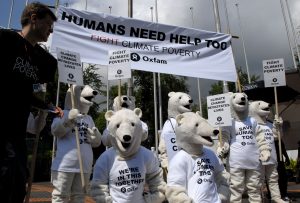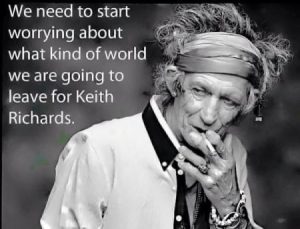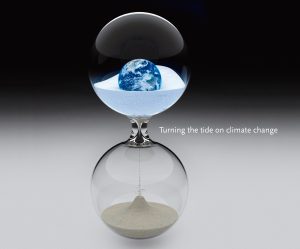Introduction: Setting the Scene
“Why aren’t people terrified? What do we have to say? What do we have to do?!”
–Dr. Randall Mindy, Don’t Look Up (2021)

Learning Objectives
By the end of this text, learners should be able to:
- Describe the basic facts of climate science.
- Compare and contrast documentary and narrative film.
- Define a Climate Fiction Film, or Cli-Fi Film.
- Identify the foundations of Cli-Fi Films.
- Describe basic categories of Cli-Fi Films.
- Identify examples of Cli-Fi Films.
- Explain why Cli-Fi Films can contribute to solving the climate crisis.
I am writing this introduction in early July from my comfortably air-conditioned (at least for now) home office in Austin, Texas. Outside, it is well on its way to a high of 106 degrees. Contrary to popular belief among non-state residents, it is usually not yet this warm in the summer in central Texas (and it is not a dry heat). But the city broke heat records in both May and June this year, and forecasters predict the hottest summer on record in Austin.
Just sixteen months ago, Texas endured what I refer to as “Snowmaggedon.” In February 2021, a historic winter storm brought extreme cold temperatures across the state that lasted for several days. One of, if not the, most costly weather disasters in Texas history, it caused widespread, multi-day road closures, power outages and loss of heat, broken pipes, and at least 246 deaths. Although extremely grateful that I and my family were not among the latter, I was without water, power, and heat for five days and had no hot water for nearly a month more. The disaster exposed serious weaknesses in the state’s power grid, prompting calls for investigations and causing ongoing anxieties and fear among Texans.
Taken alone, these are two extreme weather events. However, together they are data points providing additional and alarming evidence of climate change. Weather refers to atmospheric variations from minute to minute, hour to hour, day to day, month to month, and season to season. Climate change refers to long-term shifts in temperatures and weather patterns. As the climate action site of the United Nations explains, “[t]hese shifts may be natural, such as through variations in the solar cycle. But since the 1800s, human activities have been the main driver of climate change, primarily due to burning fossil fuels like coal, oil and gas.” But if climate change has been natural, and thus presumably been occurring throughout the history of Earth, why should we be concerned about human activities contributing to it?
Because these activities are accelerating the changes, particularly global warming, at an alarming rate. The consequences of climate change now include, among others, intense droughts, water scarcity, severe fires, rising sea levels, flooding, melting polar ice, declining biodiversity, and, as was my experience in 2021, catastrophic storms. We all should pay attention, and it is every human’s responsibility to take steps to mitigate these consequences. As Walter Shriner in Resources for Teaching Climate Change Across the Curriculum astutely argues, “It is not hyperbole to say that climate change is an existential threat to human civilization as we know it.”

As Shriner’s statement makes clear, climate change is a serious subject. But as with other serious subjects throughout history, some have attempted to address them through humor and satire, as in this meme, which plays on the ubiquitous joke that the Rolling Stone drummer – famous for his “hard living” – seems to be immortal (uncredited meme, source unknown).
The recent film Don’t Look Up (2021) boldly takes this approach. Directed by Adam McKay and starring a blockbuster cast led by Leonardo DiCaprio, Jennifer Lawrence, and Meryl Streep, the comedy was produced by Netflix, which describes it thus: “Two astronomers go on a media tour to warn humankind of a planet-killing comet hurtling toward Earth. The response from a distracted world: Meh.” Don’t Look Up captures the current zeitgeist of climate change, hilariously but pointedly depicting the refusal of so many to accept and address it, in spite of overwhelming evidence of the threat it poses to our planet and its inhabitants (not only human but all life forms, of which we are stewards). Although reviews were mixed, it received four Academy Award nominations and set a new record for the most viewing hours in a single week on Netflix, going on to become the second most-watched movie on Netflix within 28 days of release.[1]
Don’t Look Up could easily be dismissed as mere entertainment, even as some critics called its dire messaging heavy-handed. And some of those watching may have enjoyed the film, likely laughed, and moved onto their next movie or series, giving little thought to the message behind the humor. But films like these, as the viewership reveals, can reach millions, and popular actors like DiCaprio and Lawrence have influence, regardless of whether the actors’ opinions do or don’t align with those of their characters. While socio-political, scientific, and cultural trends, events, and norms clearly impact and influence film, the converse can be true as well. This has become increasingly true as first television, then video, and then streaming have extended the reach of cinema beyond the theatre or movie house. At the most granular level, films can motivate individuals to change attitudes and behaviors and change their course of action.
“Just as movies reflect the anxieties, beliefs, and values of the cultures that produce them, they also help to shape and solidify a culture’s beliefs. Sometimes the influence is trivial, as in the case of fashion trends or figures of speech. . . . However, sometimes the impact can be profound, leading to social or political reform, or the shaping of ideologies.”[2]
It is with a belief in the potentially profound impact of film that I have creating this resource. And drawing on media theorist Marshall McLuhan’s prescient, ubiquitous declaration in 1968 that “the medium is the message,”[3] I am intentionally publishing this work with an open license (except where noted for images used with fair use as well as the entirety of Chapter 1, Climate Change Science: The Facts) in order to extend its reach, since climate change affects everyone. It simply wouldn’t make sense to create barriers to accessing the information that I communicate here, so this volume joins the increasing number of open materials being developed to support climate change education in the hopes of ensuring that its potentially devastating effects on our world are not inevitable or irreversible.

With this spirit of optimism, I offer this roadmap to Telling Stories to Save the World: Climate Change in Narrative Film:
- First, I will offer an overview of climate change. For this, as a non-scientist and non-climate change expert, I will reproduce Chapter 1, “Climate Change Science: The Facts” from the excellent Communicating Climate Change: A guide for educators by Anne Armstrong, Marianne Krasny, and Jonathon Schuldt.
- Next, I will explain the text’s focus on narrative film, a category of motion pictures that tells a fictional or fictionalized story, event, or narrative (as opposed to, for example, a documentary).
- Then, I will explore the nature of the “Cli-Fi Film,” including a definition, background, and various ways to categorize them.
- The body of the text will give an overview of major narrative films focused on climate change, from Soylent Green (1973) to Don’t Look Up (2021).
- I will conclude with a consideration of the future direction of Cli-Fi Films.
Most chapters include summative questions to test your knowledge and understanding.
I am pleased you are taking this virtual journey with me, either by choice or as a course requirement. As DiCaprio’s character in Don’t Look Up warns, “This will affect the entire planet.” We all have a responsibility to address climate change. I hope the films explored here inspire you to take action!
Videos
Introduction to Telling Stories to Save the World: https://youtu.be/XzSs_bwIN6U
Don’t Look Up Official Trailer: https://youtu.be/RbIxYm3mKzI
- Don’t Look Up. Wikipedia. Retrieved July 5, 2022. ↵
- Understanding Media and Culture: An Introduction to Mass Communication (2010). University of Minnesota Libraries Publishing. Section 8.3. ↵
- McLuhan, M. (1964). Understanding Media: The Extensions of Man. Canada: McGraw-Hill. ↵
